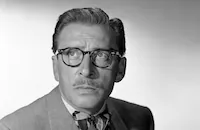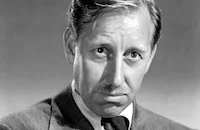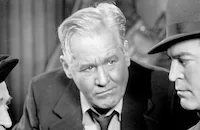Watch the Birdie

Brief Synopsis
Cast & Crew
Jack Donohue
Red Skelton
Arlene Dahl
Ann Miller
Leon Ames
Pam Britton
Film Details
Technical Specs

Synopsis
One day a bank collection agent informs Rusty Cammeron, who runs the Cammeron and Son and Son photographic supply store with his father and grandfather, that he has only one day to pay the $1,100 he owes. Soon after, a newsreel photographer enters the store and tells Rusty he can earn quick money by selling celebrity photographs. Rusty offers to store the photographer's camera for him, then secretly borrows it and begins shooting around town. His final shot of the day is of the christening of heiress Lucia Corlane's yacht, but when he tries to capture the moment, he almost drowns and has to be rescued by Lucia. After he revives, she sees he is despondent at having ruined the $1,200 camera, and so secretly arranges for her employees to buy $2,400 dollars worth of merchandise from his shop the next day. Rusty is thrilled at his new success, but soon spends all his earnings repaying the bank collector and owner of the ruined camera. Lucia, who has invested all of her inheritance in the Lucky Vista Housing Project, asks Rusty to make a photographic record of the construction, starting with the next day's groundbreaking ceremony. At the ceremony, Rusty's ineptness causes him to record several private conversations, including one in which Lucia's manager, Grantland D. Farns, offers to pay their banker, Hugh Shanway, to refuse Lucia her final loan and therefore allow Farns's friends to buy her out at a substantial loss. Rusty also films some Shanway publicity shots of the newly crowned Miss Lucky Vista with some prize turkeys. Days later, Pop Cammeron puts the film together, and Rusty, who has fallen in love with Lucia, screens it for her, Shanway and his wife, Farns and Miss Lucky Vista. The shots and soundtrack are so garbled that although the incriminating scenes are in the film, no one can hear what Farns is saying to Shanway. After the showing, Farns tries desperately to acquire the film, but Rusty insists on taking it home and fixing it. Farns then hires Miss Lucky Vista to seduce Rusty and steal the film that night, and although Rusty spurns her, Lucia catches them together and is angry. The women storm out, after which Grandpop Cammeron arrives and teaches Rusty how to attract women by showing him scenes from the movies Johnny Eager and Boom Town . The next day at Lucia's yacht, Rusty mimics the male stars's domineering attitude, causing Lucia to shove him in the water and then rescue him again, after which she forgives him. Days later, Farns steals all the cannisters in Rusty's shop but cannot find the corrected film, which Rusty is showing to Lucia at that very moment. When Farns and Shanway arrive at her office and realize she has seen the film, Shanway abducts her and Farns tries to force Rusty to give him the film. Rusty, however, beats Farns up and grabs Lucia, escaping by jumping out a second-story window onto a gigantic lumber loader. After a car chase through a plant nursery, a train and a lake, they capture Farns and Shanway, get directions from a helicopter pilot and, as Lucia accepts Rusty's marriage proposal, drive the crooks to the police station.

Director

Jack Donohue
Cast

Red Skelton

Arlene Dahl

Ann Miller

Leon Ames

Pam Britton
Richard Rober
Dick Wessel

Frank Ferguson
Willard Waterman
Lurene Tuttle
Andrew Tombes
Michael Dugan
Jeff York
Frank Hyers
Jean Vachon
Don Brodie
Jack Shea
Frank Mitchell
Frank Sully
Bill Lewin
Jim Hayward
Robert E. O'connor
Tom Dugan
Wilson Wood
Georgia Pelham
Paula Drew
Jacqueline Duval
Larry Steers
Henry Sylvester
Jack Boyle
Kathleen O'malley
Ray Cooke
Pat Williams
Wendy Lee
Harry Stanton
Redmond Doms

Joseph Crehan

May Mcavoy
Erin Selwyn
Bobby Hyatt
Crew
Carl Beonde
Fletcher Clark
William Coopersmith
Chet Davis
Otto Dyar
John Faure
Howard Fellows
Henry Forrester
Devery Freeman
Cedric Gibbons
A. Arnold Gillespie
Keogh Gleason
Sydney Guilaroff
William Hole
Eddie Imazu
Gertrude Kirkwood
Hal Millar
John Miller
Marshall Neilan Jr.
Warren Newcombe
Lillian Radar
Harry Ruskin
Harry Ruskin
Bill Shaw
Douglas Shearer
Al Shenberg
Tom Smith
Lee Stanfield
Georgie Stoll
Harry Stradling Jr.
Bob Streeter
Ivan Tors
William J. Tuttle
Paul C. Vogel
Robert Watts
Ferris Webster
John A. Williams
Edwin B. Willis
Dolph Zimmer

Photo Collections
Videos
Movie Clip



Film Details
Technical Specs

Articles
Watch the Birdie
Ann Miller is also on hand; she was hot off the classic On the Town (1949), and MGM made a point of advertising this new film as her first non-musical. She would ultimately appear with Skelton in four features, though in the first, Having Wonderful Time (1938), she was uncredited. Their other joint efforts were Texas Carnival (1951) and Lovely to Look at (1952).
Skelton and Dahl had just teamed successfully in A Southern Yankee (1948) and Three Little Words (1950), and so were paired again. It was the lovely Dahl's fifth studio assignment in 12 months; she was rapidly ascending the ladder at MGM. Soon after the release of this film, Dahl wed Lex Barker, her first of six husbands.
For Skelton, Watch the Birdie was an immediate follow-up to Three Little Words, which had been a sizable hit. This one, however, was not a moneymaker, and reviews were mixed to negative. The New York Times, for instance, said, "Either Red Skelton is weakening or his writers have sadly let him down. There is little credit in it for the star... Miss Dahl has the job of playing straight to a virtual vacuum, and Ann Miller bears up rather bravely in a small and humiliating role. The time has come for Mr. Skelton to look for a new formula."
The Hollywood Reporter, on the other hand, declared, "Skelton handles the three generations with genuine artistry. Arlene Dahl, Ann Miller and Pam Britton take care of the pulchritude side most effectively and delightfully. Miss Dahl is beautiful and capable as the ingénue, and Miss Miller shows some real comedy talent as the beauty contest winner."
Variety's review was less effusive but still positive: "Red Skelton's cornball comedy is excuse enough for Watch the Birdie. Comic's followers will like it and others will find much to chuckle at... Broad and zany, plot uses a lot of gadgets as laugh assists. Included among these are clips from two earlier Metro releases, Johnny Eager [1942] and Boom Town [1940], setting up a neat sequence that instructs Skelton in the proper wooing of a miss, instructors being Lana Turner and Robert Taylor in the first clip and Clark Gable and Claudette Colbert in the second." (In typical Variety language, the reviewer added: "In the gam display Miss Miller registers.")
Parts of Watch the Birdie were inspired by Buster Keaton's The Cameraman (1928). Keaton, in fact, was at this point working as a gagman at MGM, advising Skelton on several films. Keaton tried to talk Louis B. Mayer into letting him actually write and direct comedies with Skelton, but the studio chief refused.
Producer: Harry Ruskin
Director: Jack Donohue
Screenplay: Ivan Tors, Devery Freeman, Harry Ruskin; Marshall Neilan, Jr. (story)
Cinematography: Paul C. Vogel
Art Direction: Cedric Gibbons
Music: Georgie Stoll
Film Editing: John Faure, Robert Watts, Ferris Webster
Cast: Red Skelton (Rusty Cammeron/Pop Cammeron/Grandpop Cammeron), Arlene Dahl (Lucia Corlane), Ann Miller (Miss Lucky Vista), Leon Ames (Grantland D. Farns), Pam Britton (Mrs. Shanway), Richard Rober (Mr. Hugh Shanway).
BW-71m. Closed Captioning.
by Jeremy Arnold

Watch the Birdie
Quotes
Trivia
Notes
The working title of this film was The Cameraman. Watch the Birdie is a remake of the 1928 M-G-M film The Cameraman, directed by Edward Sedgwick and starring Buster Keaton (see AFI Catalog of Feature Films, 1921-30; F2.0752). A June 5, 1950 Daily Variety news item notes that Ferris Webster served as the film editor on the picture until early June 1950, when he accidentally shot himself in the hand and was replaced by Robert Watts, who had been the first assistant editor. A May 1950 Daily Variety news item lists Charles Lane in the cast, but he does not appear in the final film. The film contains portions from two other M-G-M films, including a clip with Lana Turner and Robert Taylor from the 1942 film Johnny Eager, and another with Clark Gable and Claudette Colbert from the 1940 film Boom Town (see AFI Catalog of Feature Films, 1931-40; F3.0416). Modern sources indicate that Keaton contributed to the comedy gags in the film but did not receive a screen credit.

Miscellaneous Notes
Released in United States Winter January 12, 1951
Released in United States Winter January 12, 1951













